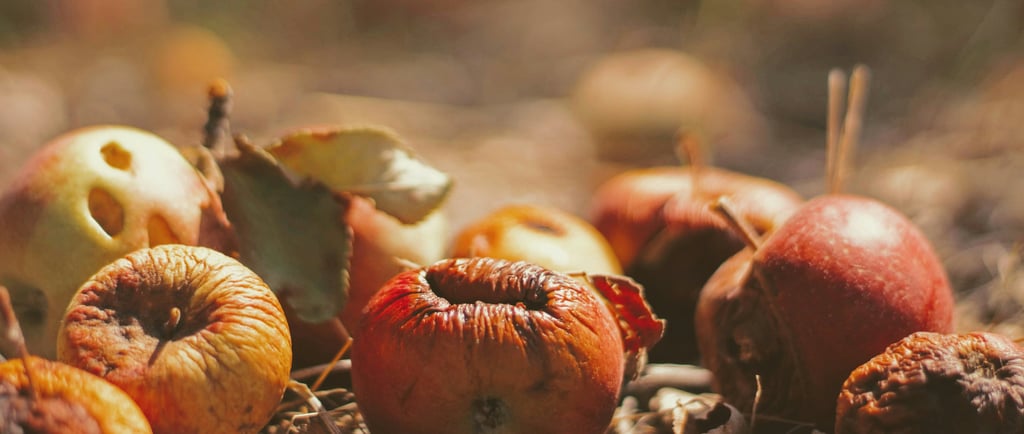Jump to...


Food waste is one of the biggest problems plaguing our food supply today. On average, it's estimated that Americans toss about a pound of food per day into the trash. Most of those scraps and leftovers can be used in meals or repurposed for new ingredients, so let's take a look at what you can do to reduce food waste in your home.
Photo by Joshua Hoehne on Unsplash
Moreover, it is required of stewards that they be found faithful.
Let's start with the facts.
Between 30 and 40 percent of our food supply is being wasted by consumers, farmers, and food manufacturers, according to Earth.org. Instead of passing on unused or unsold produce to the many hungry around us, this problem costs our great nation millions upon billions of dollars each year.
Sadly, only 2% of the extra food produced gets donated. We would do well to remember in the days of Ruth in the Bible, that generous wheat farmers would let the poor glean in their fields for free in order to feed their families. That is way more rewarding than food companies maintaining their bottom line. This is a picture of what things used to look like when it came to food waste:
She [Ruth] said, "Please let me glean and gather among the sheaves after the reapers." So she came, and she has continued from early morning until now, except for a short rest. Then Boaz said to Ruth, "Now, listen, my daughter, do not go to glean in another field or leave this one, but keep close to my young women. Let your eyes be on the field that they are reaping, and go after them. Have I not charged the young men not to touch you? And when you are thirsty, go to the vessels and drink what the young men have drawn."
What a beautiful picture of God's provision and the usefulness of the food He has created for us! We can adopt a new mindset on food waste by asking ourselves:
How can I use this part of my food before throwing it away?
How can I use this to bless someone else?
What can I do about it?
Those statistics are pretty harrowing. What a widespread and very complex problem that food waste is! Okay, so you can't solve all of that. But, you can strive to do your best to steward God's money and provisions well, and that can mean reducing the amount of food that you and your household throws away that could have been used for something meaningful. He has provided growing food as an incredible way for us to feed ourselves, and unfortunately, the food supply is in the dirty clutches of big industry. But, on a personal level, you can a difference make in your own home, starting today.
It hurts to throw away pieces of food that you know, deep down, you could have repurposed in some way. With these methods, you can stop feeling guilty, stop wasting food, and start enjoying the full benefits of what you buy! You'd be surprised on what you can make that will save you some money on grocery items, too!
1. Make vegetable broth
Did you know that you can use those random ends, skins, and even seeds of the vegetables you chop up to make a delicious vegetable broth? Just save all your scraps in a freezer baggie; and when it gets full, dump it in a pot full of water and let it simmer for an hour or more, until the veggies lose their color. And boom! You now have a homemade broth that you can use in soups and other dishes, and you don't have to wonder where it really came from or what's in it. The mix of scraps creates a unique flavor for the broth that you'll never find in the store! Here are some of the things you could use in your vegetable broth:
Bell pepper or jalapeno tops and seeds
Onion ends and skin
Garlic ends and skin
Carrot tops
Tomato tops and cores
Herb stems
Green onion bulbs
Celery base
Don't be afraid to save any and all veggie scraps from whatever other vegetables you like to use. As an added bonus, some of these ingredients such as the herb stems and carrot tops can be utilized inside the dish that you're actively making! You never know; they could add an extra layer of flavor or texture that can be delicious, and will definitely be nutritious.
4. Make some yogurt
We all know that feeling of opening the fridge and seeing that sad, forgotten half-gallon of milk sitting all the way in the back. Maybe it's been spoiled for a week or longer. Your stomach drops, because you know how much you paid for that milk--I mean come on, it's 2025. Milk definitely doesn't come at the price that our grandparents used to get it for!
Not to worry. Curdled milk is actually a wonderful addition to meals, as it can be used in the same ways as buttermilk or heavy whipping cream! It's just not very appetizing to drink, but it can be used to make biscuits, cheese, or even homemade yogurt (which is surprisingly easy)!
Pour that half-gallon into a pot and heat it until just warm to the touch. Take out 1 cup of it and mix it with 1/2 cup of Greek yogurt, then add the rest of the milk. Let that sit in your oven overnight with the pilot light on, and it will ferment into yogurt! The yellow film on top is just whey; you can either save the whey separately or just mix it into the yogurt! This works best with grass-fed raw milk and milk that has not been ultra-pasteurized. By making your own yogurt, you can give your gut the best probiotics and cultures because they are local to your everyday environment! Can a supplement do that?
Homemade yogurt is filling and delicious with a little honey or fresh fruit added. Give it a try!
5. Give your plants some love
If you're boiling foods like potatoes and eggs, think twice before you pour that nutrient-rich water down the drain! It will provide a boost of minerals and fertilizer to your soil. I store mine on the counter in a Mason jar and use it for the next watering. Your plants can benefit from it much more than the garbage disposal can.
3. Turn bread into crumbs
If you buy bread regularly, especially a homemade or whole-ingredient bread, chances are it will get hardened on the counter within a week. And while that means you can't use it as toast, stale bread means yummy bread crumbs to use in meatloaf, meatballs, and mac and cheese! Just make sure there are no fuzzy, moldy spots to be found.
If your bread is stale but still soft in the middle, you can dry it out in your oven by placing the pieces flat on a cookie sheet and drying it on 200 degrees until completely hardened. The time will vary based on how thick your bread slices are. Once they're completely dried out, blend them in a food processor and store in an airtight container. If you like, you can even add some seasoning to it when storing. Panko to the rescue!
2. Zest it up!
Fresh citrus juice can add a zingy, acidic flavor like no other to salsas, salmon, and even just plain water! But, once you squeeze out all the tangy goodness inside, then what?
Try grating the peels and saving the zest in the fridge or freezer. That way, if you need a little extra zing without cutting open a whole new orange, lemon, or lime, you can just add zest. Or, if you want to be really different, you could pickle the rinds with the peels on! Disclaimer: I have never tried pickling that type of rind. But stay tuned, because I just might! Or, if you've tried it, tell me how it went!
6. Old roots, new tricks
Speaking of potatoes, if yours have sprouted or wrinkled up, take a moment to feel and smell them. If they don't smell bitter and spoiled, take off the sprouts and use the potatoes! The same goes for ginger, garlic, or onion that looks a little funky--that doesn't necessarily mean it has gone bad, it's just doing what plants are supposed to do! Again, use your senses to determine whether or not it's still good.
8. Can't finish it? Freeze it!
The freezer is a great tool for preserving food beyond its normal lifetime. Even if you only have enough leftovers for one serving or one small snack, just freeze them! That way, when you or your family members are looking for food on one of those on-your-own nights, you'll have something good to eat. Also, when making soup, always make more than you need, so that you can freeze some of it later! It makes for a quick and handy dinner for the family, and it thaws easily in the pot.
7. Bake those bad bananas
Let's face it, browned bananas are not exactly delicious. They're extremely sweet and taste borderline rotten. However, before you toss those and stink up your entire kitchen, consider making some banana bread! This type of bread is easy to make and works best the older the bananas are! And, even if you have bananas that are primed for the dessert but you aren't quite ready to make it yet, you can just freeze the mush and use it whenever you want to!
At the rate things are going, it would take a very long time and a lot of reform to significantly reduce the food waste problem. In spite of that, let's use these methods to make a dent in it and bring glory to God by using every part of the food that He has given us!
